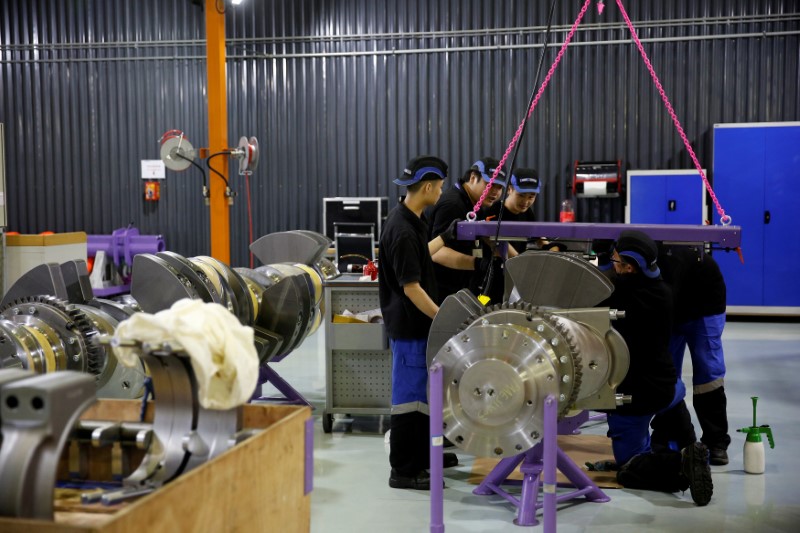By Marius Zaharia
HONG KONG (Reuters) - Factories in China and Japan motored ahead in July, giving investors optimism that the global economy can carry momentum through into the second half of the year as central banks in the West prepare to start scaling back years of massive stimulus.
Similar surveys from Europe later in the day are expected to point to strong expansion in manufacturing on the continent, while U.S. factories likely chugged along at a slightly more modest but still solid pace.
A revival in world trade this year and improving domestic demand in many economies have produced a string of forecast-beating company earnings reports in recent weeks, boosting MSCI's global stock index to record highs.
In China, factory activity unexpectedly expanded at the fastest pace in four months in July as export orders flooded in, a private survey showed on Tuesday.
The Caixin/Markit Manufacturing Purchasing Managers' Index (PMI) rose to 51.1, well ahead of June's 50.4 and the 50 break-even level.
The findings were more upbeat than official data on Monday, which suggested a slight loss of momentum. But taken together they pointed to continued resilience in the world's second-largest economy and the possibility that its industrial recovery may last a bit longer than expected.
"The key takeaway from the PMIs is China, which shows that the momentum is still ongoing into the start of the third quarter," Khoon Goh, head of Asia research at ANZ.
"The PMIs in the rest of the region are somewhat mixed. We do expect a bit of a growth slowdown (in Asia) in the second half but full-year growth numbers to be an improvement from last year's."
In Japan, there were signs that sluggish domestic demand is picking up, though stubbornly low inflation likely mean its central bank will not pare back its radical stimulus till long after the U.S. Federal Reserve and European Central Bank, which could start reducing their huge stash of bonds in the near future.
While Japanese factories saw export orders soften, a global electronics rally which has buoyed North Asia's hi-tech firms is likely to get a fresh lift heading into the peak year-end shopping season. Japan's exports rose nearly 10 percent in June.
South Korea reported a near 20 percent surge in July exports on Tuesday, driven by demand for memory chips, though heavyweights like LG Electronics may be reaping the lion's share of the trade windfall, while small firms struggle.
In Taiwan, factories kicked up production and stepped up hiring, also riding the tech boom.
The picture was more mixed for emerging economies in Asia, which factory activity shrinking in Indonesia and Malaysia.
India, one of the world's fastest growing economies, saw its manufacturing sector slam into reverse, with activity shrinking the most in over nine years as a new Goods and Services (GST) sowed confusion among producers.
CHINA, EUROPE KEY
China and the eurozone are key to the second-half outlook, with those regions seen driving a larger share of the global recovery as political turmoil in Washington imperils President Donald Trump's plans to quickly pass stimulus plans.
The International Monetary Fund last week upgraded its growth projections for China and Europe, while keeping its global forecast at 3.5 percent.
The euro zone July manufacturing PMI is seen hitting 56.8, matching the June figures.
In the United States, the Chicago PMI came in overnight at 58.9, off June's three-year high of 65.7 but still solid. The ISM manufacturing PMI later on Tuesday is expected to slip to 56.5, from the previous month's 57.8.
Full-year growth in China is widely expected to handily meet the government's target of 6.5 percent, after stronger-than-forecast growth of 6.9 percent in the first half, driven by a year-long building boom, solid exports and retail sales.
Official data showed construction activity accelerated in July, despite expectations of a slowdown. But most analysts still expect the broader economy will begin to cool eventually as regulators maintain a clampdown on riskier types of lending which is pushing financing costs higher.
"We don't think this pick-up is sustainable ... given the increasing headwinds from policy tightening,," Capital Economics China Economist Julian Evans-Pritchard said.
The threat of growing U.S. protectionism also continues to hang over Asia's trade-reliant economies.
Though Trump did not follow through on many of his protectionism threats made during the campaign, there are signs the U.S. administration is growing frustrated at a lack of concessions from its major trading partners.
The United States and China failed last month to agree on major steps to reduce the U.S. trade deficit with China, and tensions over North Korea may further strain relations. The U.S. is considering fresh curbs on steel imports.
DIVERGING POLICY PATHS
While the Fed and ECB are expected to slowly normalize policy after years of cheap money, Asian central bankers are likely to be more cautious about tapping the brakes for fear of derailing their recoveries, ANZ's Goh said.
Australia's central bank kept its cash rate unchanged at a record low 1.5 percent on Tuesday, despite saying the domestic and global economy continue to improve.
"Labor markets have tightened further and above-trend growth is expected in a number of advanced economies, although uncertainties remain," it said in a statement.

Bucking the global trend, the Reserve Bank of India is expected to cut rates on Wednesday after inflation eased to the lowest in more than five years.